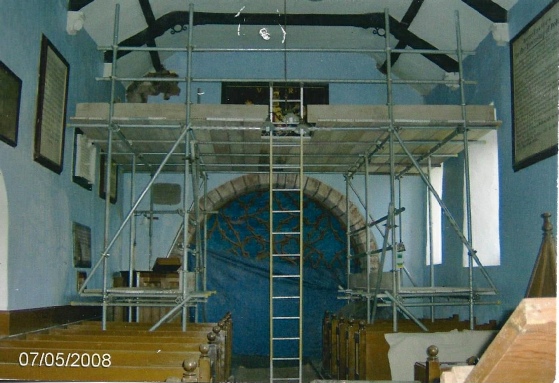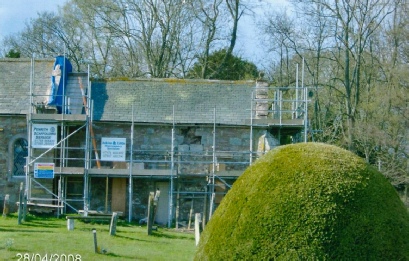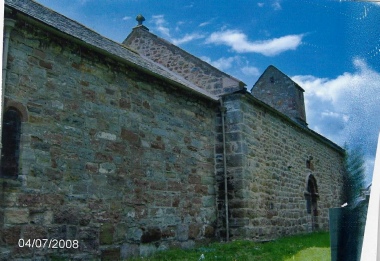History Ch 2
All Saints Church Bolton
A Grade 1 Listed Building

In the Commonwealth Survey of 1649 Bolton was a chapelry in the parish of Morland and described as belonging to the vicar of Morland with one house for the curate abutting onto the churchyard. It remained in the parish of Morland until 1868 and with Morland church was attached to the priory at Wetheral near Carlisle. According to the Royal Commission for Historical Monuments the church was built in the second half of the 12th century and has been the focus for the community’s religious and social activities throughout the ages.
The Clerks accounts for 1732 record 0-2– 0d spent for Gunpowder treason an annual event and in 1762. 0-2-0 d For Coronation day presumably to celebrate the accession to the throne of George third in 1760.
The chapel had no maintenance but the vicar of Morland’s duty was to find a reader there and pay him £7 a year out of his Tithes and Glebe land. There was a high turnover of curates reflecting the poor living. In 1753 the living was augmented by £1000; with £800 from Queen Ann’s Bounty in the years 1754, 1761, and 1785 and £200 was given by the Countess Dowager Gower daughter of the third Earl of Granville. Two estates were purchased with £800 (Glebe Farm now Glebe House and Bewley Farm) the remainder was used to purchase the Scarside estate at Orton.
In 1829 the land owners were patrons to the curacy which was valued at £4 -0 – 0 d with £3 per year paid by the vicar of Morland and £1-10-0 d from the produce of the yard, surplice fees, tithes of garths chickens,eggs,ducks,hemp and flax.
The chapel was to be rebuilt in 1829 with £100 from the Society for the Building of New Churches but this does not appear to have happened. Most of what can be seen today is from the restoration in 1848 during the incumbency of the Reverend William Shepherd who was curate from 1833 – 1880. There are still several interesting Norman features remaining.
The earliest work is to be found in the Nave especially the North and South doorways and the western portion, originally part of a tower, with north, south and west walls four feet thick. The eastern wall was possibly removed at some later time, perhaps to enlarge the Nave. The north and south walls continue eastwards and are nearly three feet thick. It is said they were rebuilt in the 16th century on the old lines.
In 1678 £16 was spent on restoration and it was about this time that the bell turret was added, the Chancel walls raised and the roof reconstructed. There was always a necessity to maintain the church and money was paid annually for glazing the windows of the church and in 1762. 0-2-0 d to Thomas Longmire for Mending the pulpit
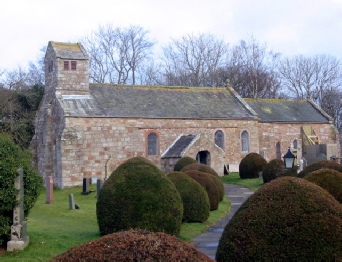
Today the view of the church shows a small sand stone building with a bell tower set at the end of an avenue of Yew’s. A walk around the church and churchyard takes us on a journey through many centuries of the church noting past inhabitants of Bolton as we go.
In the churchyard to the left of the porch is the stone effigy of a lady upright against the wall. Her hands are clasped across her breast and she is dressed in a long cloak or dress which could be that of 12th century Norman.
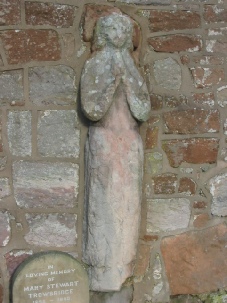
Her head appears to be resting on a pillow suggesting that she may once have lain on a tomb which could have been inside the church, although in the churchyard near the east wall of the chancel is a thick stone slab on which the effigy might previously have lain.
Moving further to the left on the southwest corner of the church, on the face of the buttress and scratched into the stone is what some describe as an ancient sundial, said to be used to indicate when services would be held.
These “sun dials” are found on other churches throughout the British Isles, sometimes found inside the porch which is not the best places for a sun dial, so their meaning is unclear. They may be remnants of old religions. Charles Cox notes in the County Churches of Cumberland and Westmorland that these small sundials occur on other churches in the county and are believed to be Saxon dials denoting the existence on the site of a previous Saxon Church.

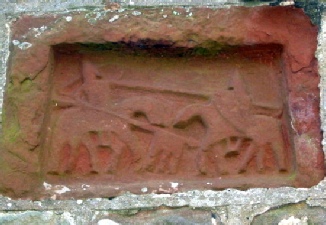
On the North side of the church and built into the wall is a relief in red sandstone of two knights fighting; its significance is unknown, perhaps it commemorates a tournament or a memorial to a knight fighting the infidels in the crusades. Over the years it is being slowly worn away by the weather and pollution. (There is a replica of the relief inside the church) Beside it is evidence of another relief which is possibly a companion to the Knights now almost completely worn away. It was inscribed:
=Ds LVRREN DE .WERE
DVN:Qs: HoM ES DE .BO
ELTVN: + .II .OMRS:QV
SeAT IF Mtop was stV . R.ESNE
LVRLALYV R:OS
+RAT : O N . RAM
DSLVRHEI
The only part to be translated to date – Sir Lawrence de Vere gives to the men of Bolton……so we may never know what was given to the men of Bolton. Could the two reliefs relate in some way to the Knights Templars?
The Knights Templars had property at Temple Sowerby a short distance from Bolton sometime during the reign of Edward the second. What there is left of the description of the property they owned there makes reference to a water mill, millpond with eels and with a total income of £7 – 3 – 0d per year. The property is that which we know of as Acorn Bank to-day.
To the right of the church porch lies a Grade 2 listed tomb that of William Bowness benefactor to the school. His will requests that the rent from land he owned be distributed upon his tombstone to the poor of Bolton by the church wardens on the feast of Saint Thomas the Apostle every year forever. There is also a tablet inside the church on the north wall of the Nave recording the bequest by his will dated February 9th 1709.
Further to the right of the porch are some table top tombs and a Grade 2 listed sun dial erected by the church wardens in 1747 inscribed with CHURCH WATCH and the initials JB and RA (James Bowness and Richard Allen) the pillar stands on a medieval cross-base stone; the stone for the cross – base was possibly extracted from Bolton Quarry. Unfortunately the top was stolen in 1985 but we know from records the sundial plate was signed and dated “Carlisle Spedding 1746”. The church wardens’ accounts show 14/- for the erection of the sun dial and 1/6 for beer for the occasion.
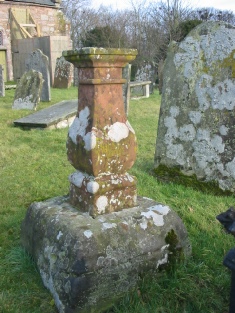
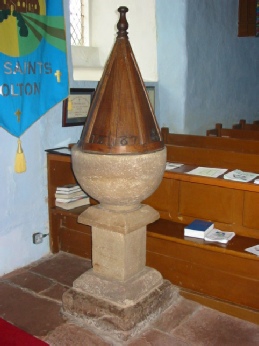
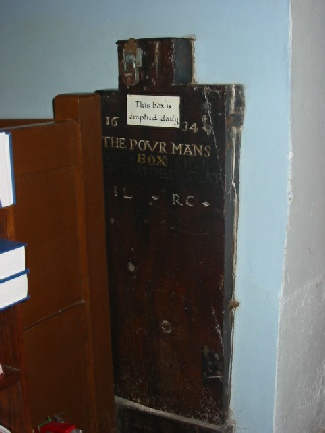
Stepping into the church through the porch which was added in the 18th century we can see the inner Norman doorway circa late 12th century. The door has an attractive pattern of six petaled rosettes within circles to the left of a figure holding a large hammer shaped object in the right hand and an axe in the left hand. On the other side is a figure which looks as if it is winged and with wide spread legs. The carvings are worn and the moulded bases decayed. To the left resting on a stone seat is the tomb stone of James Hanson parish clerk who died aged 79 in 1721 and his wife Elizabeth. The stone was part of a much bigger memorial attached to the south east church wall outside. It had to be removed because it was slowly pulling the wall down.
Moving further inside the church the font can be seen on the left.It is not dated but is probably the same date as the cover which is made of oak with the initials TG (Thomas Gibson) and WH (William Hanson) and the date 1687.
To the right of the door fastened to the wall is a wooden poor box with a dated inscription, partly painted out “1634. The pour mans box and churchwardens seat” and the initials IL and RC.
Opposite on the north wall is a former Norman doorway now a window; at one time the Nave ended on a line with this window and we would be stood in the middle of what might have been the west tower. The wall on the far side of the vestry is more than four feet thick and has large buttresses; the staircase leads to the gallery where at one time there might have been a large belfry. Today above the gallery and an arch is the bell tower restored in 1985 to the memory of James Bell. There are two bells cast by W Scott of Wigan in 1693. The church wardens in 1694 “disbursed to Robert Lacklan for carrying the bells 8/-. To William Cookson for touching the Bells 1/- and to William Bowness for work and a rope 3/-.
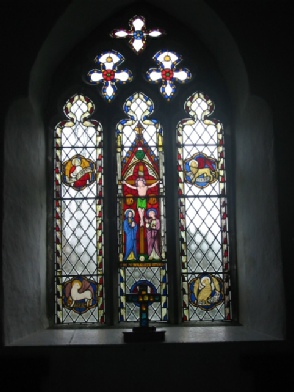
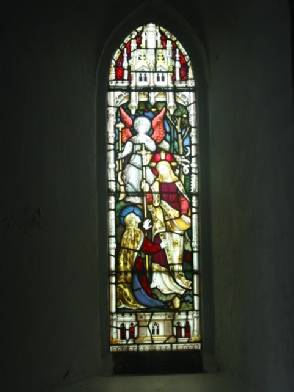
At the communion steps the windows on the north and south walls are late 12th century but the stained glass in the east window dates only from 1847. There is some very ancient glass in the arched window above the priest’s door and set into the glass is a small shield showing the arms of the Derwentwater family.
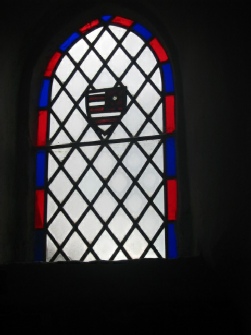
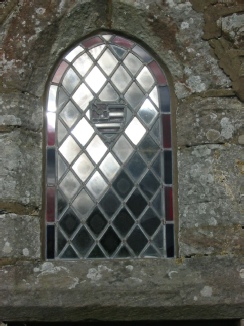
Whoever was commissioned to make the shield made the mistake of positioning the cinquefoil in the right hand corner when it should be in the left corner? The de Derwentwater dynasty ended when there was no male heir and in 1417 the estates passed into the Radclyffe family when the heiress of John de Derwentwater, Elizabeth married Sir Nicholas Radclyffe, Sheriff of Cumberland. The Radclyffes originated from Radclyffe Tower in Lancashire before the 12th century and were of equal nobility to the de Derwentwaters and when they took over as Lord of the Manor retained the name Derwentwater. The ancestors of Sir John Derwentwater held the manor from the time of King John and a chantry was founded at Bolton by his family in 1326 to sing masses for their souls.
The very low window on the south side is a leper window to give those parishioners, suffering from leprosy and standing in the churchyard a view of the priest as he took the service. The other window in the south wall shows the Risen Lord and is dedicated to the memory of Mary Graham of Eden Grove in 1908.
The oak screen in the chancel is thought to date from the restoration of the church in 1848. The chest to the right of the screen is made of large slabs of wood 2 inches thick circa 17th century. It may have held all the parish records in ancient times. In 1678 it is recorded that there were 34 pews and 125 seats. The pews would have been occupied by the Yeomen of the village and the men would have sat on the one side of the church and the women on the other. The remaining five pews were in the chancel and were removed in about 1927; the wood being used to make the choir stalls and two reading desks. Electric lights were fitted in place of oil lamps in 1934. The Monumental Survey of 1837 records the church pewter plate as probably of 18th century amongst which is a mug 6 inches high, a flagon 7 inches marked on the lid and inscribed The Gift of George Harrison of Whitfield Brow To The Inhabitants of Bolton For the Church.
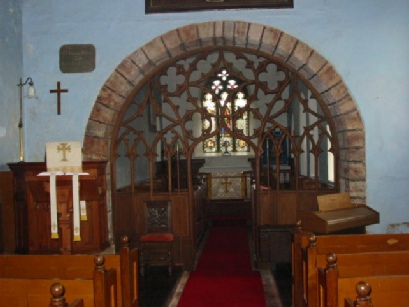
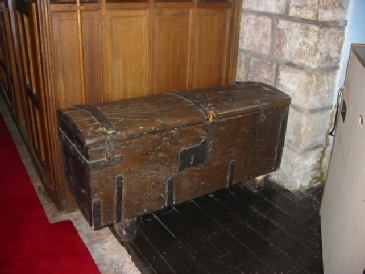
In more recent times many members of the village community have been involved in making their own contributions to the church, most notably that of a programme of fund raising begun in 2006 to meet the costs of extensive restoration. The building was found to be in urgent need of high level structural repairs to both the roof and walls to prevent the ingress of water, the partial collapse of walls and improvement of ventilation within the building. The restoration was begun in 2008 with the majority of the most urgent repairs (phase one) being completed by July of that year.
